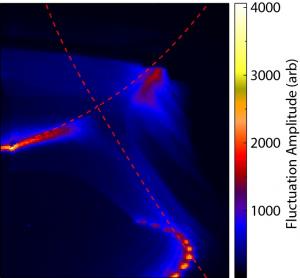Turning the tables on turbulence
21 Sep 2015
-
Culham Centre for Fusion Energy, CCFE
Image of plasma fluctuations in the MAST divertor, showing where the filaments are brightest and instabilities are strongest.
Plasma turbulence has been the bane of fusion scientists for decades. But now they're getting their own back—images of plasma inside the MAST tokamak at Culham are showing how turbulence could actually tackle one of the hottest issues in fusion reactor design.
Plasma is a fascinating but frustrating fact of life for researchers developing fusion energy. The fourth state of matter, despite making up most of the universe, still holds many secrets for Earth-bound physicists. Controlling this incredibly hot ionised gas in a magnetic field within a tokamak is a proven way of triggering fusion reactions, but the downside is that the plasma becomes turbulent and unstable, making it difficult to confine—analogous to the creation of blobs in a lava lamp, or the break-up of clouds in the sky.
The MAST videos provide the closest view yet of plasma in the tokamak's exhaust system, the divertor, and may hold the key to dealing with the intense heat ejected from the fusion chamber onto surrounding surfaces. This is a major concern for researchers designing full-scale tokamak power plants.
The divertor, made from extremely tough materials, acts as a target for the waste plasma, and pumps helium ash and impurities out of the tokamak. But in a fusion power plant the divertor will be exposed to power loads of tens of megawatts per square metre (many times greater than a spacecraft re-entering the atmosphere), putting a strain on even the toughest of structures.


